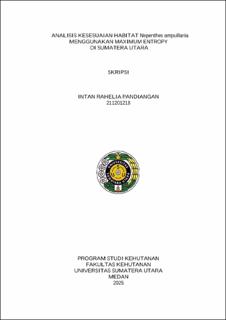Analisis Kesesuaian Habitat Nepenthes ampullaria Menggunakan Maximum Entropy di Provinsi Sumatera Utara
Analysis of Nepenthes ampullaria Habitat Suitability Using Maximum Entropy in North Sumatera Province

Date
2025Author
Pandiangan, Intan Rahelia
Advisor(s)
Rambey, Ridahati
Sidabukke, Simon H
Metadata
Show full item recordAbstract
Nepenthes ampullaria is one of the native species in North Sumatra that has ecological and economic value, but its existence is threatened by habitat degradation. This study aims to: (1) analyze the suitability of Nepenthes ampullaria habitat in North Sumatra Province with the SSP245 bio-climate scenario for the 2021-2040 timeframe, and (2) analyze vegetation in Nepenthes ampullaria habitat in three Protected Areas of PT Toba Pulp Lestasi Estate Aek Nauli, namely the Wildlife Preservation Area, the Riverbank Forest Area, and the Germplasm Preservation Area. To determine the prediction of habitat suitability using Maximum Entropy spatial modeling that utilizes environmental variables such as slope, altitude, soil type, distance from river, land cover, aspect, and bioclimate. The vegetation analysis was conducted using nested sampling plots with an area of 1 ha with a size of 20 m x 20 m. Modeling results showed that land cover (54.2%), and soil type (35.9%) contributed the most. Model validation with an average AUC of 0.755 showed excellent model performance. In the habitat of Nepenthes ampullaria, the dominating species from each location in the understory were Sticherus truncates (IVI 33.32%), Dicranopteris linearis (IVI 43.48%), and Clidemia hirta (54.72%). At the seedling level, Litsea brachystachys and Catanopsis tungurrut dominated the three locations. At the pole level, the dominant species from all three locations was Litsea brachystachys, while at the tree level, the dominant species from all three locations were Litsea brachystachys, Catanopsis tungurrut, and Gossypium hirsutum. Species significantly associated with Nepenthes ampullaria were Clidemia hirta, Dicranopteris linearis, Litsea brachystachys, Excoecaria cochinhinensis, Catanopsis tungurrut. Total clumps of Nepenthes ampullaria in the Wildlife Conservation Area were 79 clumps, Riverbanks were 25 clumps, and in the Germplasm Preservation Area were 4 clumps. This study provides a scientific basis for conservation and cultivation efforts of Nepenthes ampullaria. Further research is needed to monitor the impact of land cover change and soil type on the distribution of this species.
Collections
- Undergraduate Theses [2162]
